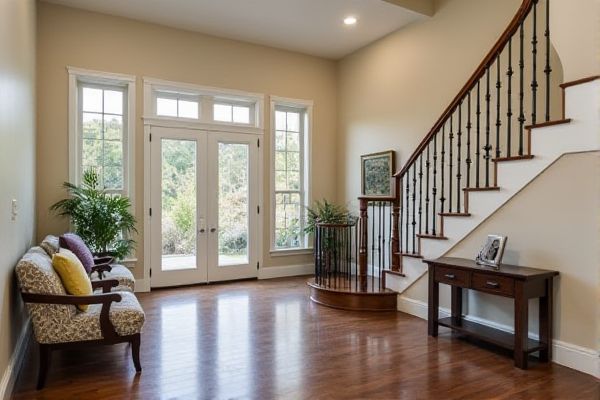
Iron balusters offer unparalleled durability and a modern aesthetic with low maintenance needs, while wooden balusters provide a warm, classic look with customizable designs but may require more upkeep over time. Discover which option best suits Your home's style and maintenance preferences by reading the rest of this article.
Table of Comparison
| Feature | Iron Balusters | Wooden Balusters |
|---|---|---|
| Durability | Highly durable, resistant to weather and wear | Moderate durability, prone to rot and insect damage |
| Maintenance | Low maintenance, occasional cleaning required | Requires regular painting or sealing |
| Design Options | Intricate, modern, and classic styles available | Versatile, can be carved or turned into various styles |
| Cost | Generally more expensive upfront | More affordable initially |
| Weight | Heavier, requires sturdy installation | Lighter, easier to install |
| Environmental Impact | Often made from recycled metal, recyclable | Renewable source but involves deforestation |
| Safety | Strong and secure | Secure but can crack or splinter over time |
Introduction to Iron and Wooden Balusters
Iron balusters provide a durable, low-maintenance option with a sleek, modern aesthetic often favored in contemporary and industrial designs. Wooden balusters offer a warm, traditional look that can be easily customized through staining or painting to match classic or rustic interiors. Your choice depends on the desired style, durability needs, and maintenance preferences for stair railing projects.
Material Composition and Aesthetics
Iron balusters are composed of wrought or cast iron, offering exceptional durability and a sleek, modern aesthetic that can be customized with intricate designs and finishes. Wooden balusters, made from hardwoods such as oak or maple, provide a warm, traditional look with natural grain patterns that enhance classic or rustic interiors. Your choice depends on whether you prefer the robust, industrial feel of iron or the timeless, cozy appeal of wood to complement your staircase design.
Durability and Longevity
Iron balusters offer superior durability and longevity compared to wooden balusters, as they are resistant to warping, cracking, and insect damage. Their robust construction withstands harsh weather conditions and heavy use, making them ideal for both indoor and outdoor applications. Choosing iron balusters ensures your railing system remains structurally sound and visually appealing for decades without extensive maintenance.
Maintenance Requirements
Iron balusters require minimal maintenance, typically needing only occasional cleaning and rust prevention treatments to maintain their durability and aesthetic appeal. Wooden balusters demand more frequent upkeep, including sanding, painting or staining, and protection from moisture to prevent rot and insect damage. Choosing iron balusters reduces the long-term effort and cost associated with regular maintenance compared to wooden alternatives.
Cost Comparison: Iron vs Wooden Balusters
Iron balusters generally have a higher upfront cost compared to wooden balusters due to the materials and manufacturing processes involved. Wooden balusters tend to be more budget-friendly, especially when using common types like pine or oak, but may incur higher maintenance costs over time. Durability and longevity of iron balusters often justify their initial expense, reducing long-term costs associated with repairs or replacements.
Installation Process and Complexity
Iron balusters require precise measurements and may involve welding or using special connectors, making the installation process more complex and time-consuming compared to wooden balusters. Wooden balusters are generally lighter and easier to cut or customize on-site, allowing for quicker installation with standard tools. Your choice between iron and wood will impact the installation difficulty, with iron often requiring professional skills to ensure safety and durability.
Design Versatility and Customization
Iron balusters offer exceptional design versatility with intricate patterns and its ability to be molded into unique shapes, providing a modern or industrial aesthetic. Wooden balusters, on the other hand, bring natural warmth and can be easily customized through stains, paint, and carving for traditional or rustic styles. Your choice depends on the desired look and level of customization, as iron suits detailed designs and wood allows more flexibility in finishes.
Safety and Structural Integrity
Iron balusters offer superior safety and structural integrity due to their strength and durability, making them less prone to bending or breaking under pressure. Wooden balusters, while aesthetically versatile, are more susceptible to damage from moisture, pests, and physical impact, which can compromise their stability over time. Choosing iron balusters enhances long-term safety by providing a robust barrier that can withstand heavy loads and harsh environmental conditions.
Environmental Impact and Sustainability
Iron balusters offer superior durability and recyclability, reducing the need for frequent replacements and minimizing environmental waste compared to wooden balusters, which often come from deforestation and have a limited lifespan. The production of iron involves higher initial energy use but benefits from long-term sustainability due to its recyclability and lower maintenance requirements. Your choice between iron and wooden balusters can significantly influence the ecological footprint of your project, especially when prioritizing renewable resources and longevity.
Choosing the Right Baluster for Your Home
Iron balusters offer unmatched durability and a sleek, modern aesthetic, making them ideal for homes seeking a contemporary look, while wooden balusters provide a warm, classic charm with customizable designs and finishes. Your choice depends on maintenance preferences and style goals; iron requires minimal upkeep and resists wear, whereas wood can be refinished but may need more care. Consider your home's overall design and the balance between longevity and traditional appeal when selecting the perfect baluster.
 homyna.com
homyna.com